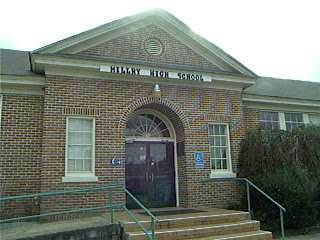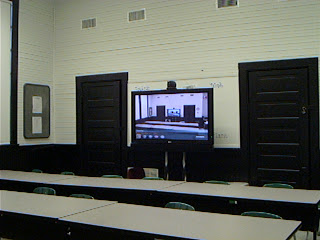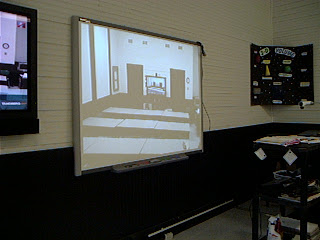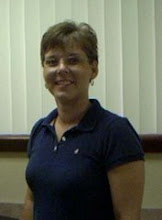Well, ladies and Matt (gentleman) we did it!!! It was a pleasure attending class with all of you. We laughed and occasionally fussed, but all in all I would say we had a good time.
Matt, I have to say thank you for putting up with Susan, Keller and I as we shared our country bumpkin stories.
To all of you I hope you achieve all your hopes and aspirations in your task of higher education.
May God Bless YOU!!!
Tuesday, December 2, 2008
Access Lab Visit - Millry High School

For my access lab visit I chose Millry High School. I had two reasons for choosing Millry: 1 - I am a graduate of Millry High School and 2 - I wanted to compare the school from then (1992) until now. Wow, was I amazed at the advance in technology at the school. I remember having only one computer lab with about 15 computers max, that had the monologue screens. Now they have two computer labs equipped with 30 computers each and an ACCESS lab equipped with a laptop for each student.
I was greeted by one of my former math teachers Coach Odom, whom is now the
 principle at Millry High School. He escorted me to the ACCESS Lab and as I entered my jaw dropped. This technology was beyond what I had imagined. As I walked into the room I saw two huge what appeared to be plasma TVs on either end of the room, with cameras above them. It is my understanding that through this technology teachers can teach remotely and still interact with the class. In addition there is a smart board which I found to be the coolest educational technology tool I have ever witnessed. Mr. Odom then directed me to a metal box setting near the door. This box contained laptops for the studen
principle at Millry High School. He escorted me to the ACCESS Lab and as I entered my jaw dropped. This technology was beyond what I had imagined. As I walked into the room I saw two huge what appeared to be plasma TVs on either end of the room, with cameras above them. It is my understanding that through this technology teachers can teach remotely and still interact with the class. In addition there is a smart board which I found to be the coolest educational technology tool I have ever witnessed. Mr. Odom then directed me to a metal box setting near the door. This box contained laptops for the studen ts participating in the lab. He informed me that the total cost of the lab was around $87,000. However, through a state program the school only had to pay $2,000 of that amount, due to furniture expenses. At this time the lab is not being used, but beginning January 2009 it will be in full swing.
ts participating in the lab. He informed me that the total cost of the lab was around $87,000. However, through a state program the school only had to pay $2,000 of that amount, due to furniture expenses. At this time the lab is not being used, but beginning January 2009 it will be in full swing.Mr. Odom and I then walked across campus to the computer lab. In the lab, stu
 dents take web-based courses offered through ACCESS. I was then introduced to Ms. Pam Clarke the technology teacher at the school. She informed me that 11 students were taking courses through ACCESS, 9 students are taking psychology as an elective and 2 are taking physical science for regular credit. Ms. Clarke expressed how pleased she was about the students performance in the classes offered and was excited about being able to offer more through interaction in January 2009. Ms. Clarke herself will be trained to teach an interactive class through ACCESS.
dents take web-based courses offered through ACCESS. I was then introduced to Ms. Pam Clarke the technology teacher at the school. She informed me that 11 students were taking courses through ACCESS, 9 students are taking psychology as an elective and 2 are taking physical science for regular credit. Ms. Clarke expressed how pleased she was about the students performance in the classes offered and was excited about being able to offer more through interaction in January 2009. Ms. Clarke herself will be trained to teach an interactive class through ACCESS.
Electronic Interaction

My electronic interaction took place on wikispaces.com on shifthappens. After being accepted into shifthappens I sent a mass e-mail to all members of shifthappens and received a reply. My reply was from Barry Jahn of Salem, OR. He is currently a professor a George Fox University where he teaches ED 556 (Pedagogy- Technology focus). He has been an educator for over 35 years, and developed an award winning technology based program for Talented and Gifted Math students in grades 4 and 5 in his school district. Mr. Jahn is presently researching Web2.0 tools and how to integrate them into F2F and eLearning environments. He was a Lead Developer and Reviewer for creating online courses that utilize these tools. He also travels around in order to do presentations and workshops at conferences and school districts around the state. Mr. Jahn has a very impressive vita, which can be viewed on his google site barryjahn.com.
During our interaction I asked Mr. Jahn "How is technology changing education?". He replied, "This is a very broad question." He then went on to inform me that if there were a simple answer he suggest the National Educational Technology Standards and Performance Indicators (NETS) for students, teachers and administrators. Mr. Jahn states, "I'm a firm believer in these goals and have participated on teams that helped derive them and improve them over the years". These standards are set by the International Society for Technology in Education, which has served as a road map since 1998 for improved teaching and learning by educators. These standards help to measure proficiency and set goals for knowledge, skills and attitudes need to succeed in today's Digital Age.
In Mr. Jahn's blog, Barry's E-Learning Resources he posts related materials about his research on Web2.0 Tools and links to innovative uses in education.
This contact was very beneficial to me as an educator. By knowing about this information and standards this will allow me the resources I need to actively integrate technology in the classroom.
Monday, December 1, 2008
What I learned in EDM 310.........
Well where do I begin. In the beginning I would have to say that I was thinking OMG! I just thought I knew about technology. I have used computers my whole life and never realized what I was missing until now. This class has taught me that learning is fun, no "Burp Back Education" here. It was a challenge, but as I learned the more I enjoyed. By learning the usefulness of technology through websites, web pages, databases, blogs and podcast this will enable me to be a better educator.
I intend to use these technological resources in my classroom in hopes of creating a classroom environment free of "burp back".
Most of all I have built relationships with my peers. The comments on my blog really helped me. They were encouraging, while also creating good laugh now and then. It was funny, the way I kept checking to see who commented on my blog. Thanks to all that commented on my blog.
I intend to use these technological resources in my classroom in hopes of creating a classroom environment free of "burp back".
Most of all I have built relationships with my peers. The comments on my blog really helped me. They were encouraging, while also creating good laugh now and then. It was funny, the way I kept checking to see who commented on my blog. Thanks to all that commented on my blog.
Pros and Cons of Blogs in the Classroom
I chose to read to blog of Keller Leathers. I was surprised to see that Keller had also read my blog, however this made me nervous as I began to read. Keller and I are both from rural communities and had not the foggiest idea as to what a blog was. However I found blogging to be a very interesting and helpful tool.
As I started my adventure in blogging I was very insecure. I usually posted my blogs early and found it very helpful as to the comments that I received. However, I was called a nerd a time or two. Anyway I would say that just as receiving those comments helped by insecurities it should also help students with the same insecurities. But it could also be used in a negative way, like cyber bulling. Children are so cruel today they do not understand the damage that could be done even if it is just a "joke" as they like to say. A "joke" cause a 13 year old boy to kill himself.
As educators it is important to stay a grasp to technology, but at the same time boundaries should be explained. If bulling is not accepted in the classroom, then it surely should not be accepted through a classroom blog. In order for a blog to be effective comments should be monitored. This will stop negative comments before they ever are seen.
In the view of a parent, blogs can be very helpful. How many times has a child forgot a backpack, leading to a total panic attack. It would be simple if a blog was utilized in the classroom. The blog would contain homework information, up coming events and class activities. It would eliminate the backpack panic attack.
Students could even create there own blogs. This will allow them to express their interest about different things that they learned. It would help them to develop much needed creative writing and grammar skills. However, in a low socioeconomic society blogging for students would be limited to school. However limited I say let them learn where and while they can. Students should explore and learn all they can and if school is there exploring time, let them explore. That's what it's all about, seeing that expression of "wow I didn't know that".
In conclusion, I say BLOG ON!! (It's been fun!)
As I started my adventure in blogging I was very insecure. I usually posted my blogs early and found it very helpful as to the comments that I received. However, I was called a nerd a time or two. Anyway I would say that just as receiving those comments helped by insecurities it should also help students with the same insecurities. But it could also be used in a negative way, like cyber bulling. Children are so cruel today they do not understand the damage that could be done even if it is just a "joke" as they like to say. A "joke" cause a 13 year old boy to kill himself.
As educators it is important to stay a grasp to technology, but at the same time boundaries should be explained. If bulling is not accepted in the classroom, then it surely should not be accepted through a classroom blog. In order for a blog to be effective comments should be monitored. This will stop negative comments before they ever are seen.
In the view of a parent, blogs can be very helpful. How many times has a child forgot a backpack, leading to a total panic attack. It would be simple if a blog was utilized in the classroom. The blog would contain homework information, up coming events and class activities. It would eliminate the backpack panic attack.
Students could even create there own blogs. This will allow them to express their interest about different things that they learned. It would help them to develop much needed creative writing and grammar skills. However, in a low socioeconomic society blogging for students would be limited to school. However limited I say let them learn where and while they can. Students should explore and learn all they can and if school is there exploring time, let them explore. That's what it's all about, seeing that expression of "wow I didn't know that".
In conclusion, I say BLOG ON!! (It's been fun!)
Duke University

In this podcast, Tim Tyson and Tom Rankin discuss the origins of the course "The South in Black in White". They feel that this course will enlighten the history and literary content of the South.
The "Front Porch" approach of the course will allow Southern storytellers to express their own rich cultures. It will show strengthens and weaknesses while displaying who the South really is and were the South wants to go.

The course is to be held at the Hayti Heritage, which holds a rich history in itself. Topic discussed in the course will consist of: race relations in Durham, the Duke lacrosse situation and the role of public education.
I think it is important to embrace the historical value of the South, no matter how grim it may be. Many associate the South with a number of slurs, but I look at the South as a rich heritage. If you look at all historical facts you will find a little grimness to them all. It's not just white and it's not just black. It's about the South and what the South has overcame and was it to come.
Synopsis of course content from Duke University.
“The South in Black and White” is a lecture and discussion course. We will focus on the history and culture of the 20th century South, a region of the heart, the mind, and the United States where democracy has been envisioned and embattled with global consequences. We will constitute a kind of front porch on Southern history, where we will join those whom Zora Neale Hurston called “the big picture talkers” and hear their stories. Each week there will be music, poetry, film clips, and opportunities for discussion. There will be music, poetry, documents and stories every day. We will explore a history as rich and complicated, painful and delightful as the South itself.
Monday, November 10, 2008
EDM 310 Podcast

Well guys we did pretty good on these podcast. We even sounded like we knew what we were talking about. I say hats off to everyone!!!! If you would like to listen to the podcast I selected just click on the highlighted topic.
However, it is a requirement that I must critic. So, I'll start with my own. I was joined with Susan Smith and Angela Minish in a discussion about ACCESS. The podcast answered the questions, what is ACCESS, how does it work and how does it impact the classroom. The podcast was very informing, however got a little to wordy. I think it could be improved with more discussion about ACCESS among all three, a more back and forth discussion. But, we did pretty darn good!!!
 I chose two other blogs from Ms. Averitt's EDM 310 class both concerning Blogging and Blogging Experiences. Kimberly, Brooke and Ashley informed us about Blogging. They explained what a blog is, how they may be used and discussed blogs they found useful. They did a great job, but again
I chose two other blogs from Ms. Averitt's EDM 310 class both concerning Blogging and Blogging Experiences. Kimberly, Brooke and Ashley informed us about Blogging. They explained what a blog is, how they may be used and discussed blogs they found useful. They did a great job, but again I must admit that more back and forth discussion would have made the conversation more interesting. Rachael, Keller and Joye talked about their Blogging Experiences. They were the first of the class to present their podcast and were a hard act to follow. I recall everyone looking at one another with that OMG look on their faces. There were a few bumps in the podcast, little stutters, but overall was very informative and interesting. Good job!!
I must admit that more back and forth discussion would have made the conversation more interesting. Rachael, Keller and Joye talked about their Blogging Experiences. They were the first of the class to present their podcast and were a hard act to follow. I recall everyone looking at one another with that OMG look on their faces. There were a few bumps in the podcast, little stutters, but overall was very informative and interesting. Good job!! I had to listen to the "Burp Back Education" podcast, since I'm not a real big fan of it either. Ashley Denson, Sandy Presley and Robyn Terry did a great job on discussing the pros and cons of Burp Back Education. They explained that burp back is passive learning, a memorization game. I agree that students must be "inspired rather than required" as stated in the podcast. They also had a few stutters and bumps but overall did a good job. Just a little to many giggles during the podcast.
I had to listen to the "Burp Back Education" podcast, since I'm not a real big fan of it either. Ashley Denson, Sandy Presley and Robyn Terry did a great job on discussing the pros and cons of Burp Back Education. They explained that burp back is passive learning, a memorization game. I agree that students must be "inspired rather than required" as stated in the podcast. They also had a few stutters and bumps but overall did a good job. Just a little to many giggles during the podcast.
Subscribe to:
Comments (Atom)

